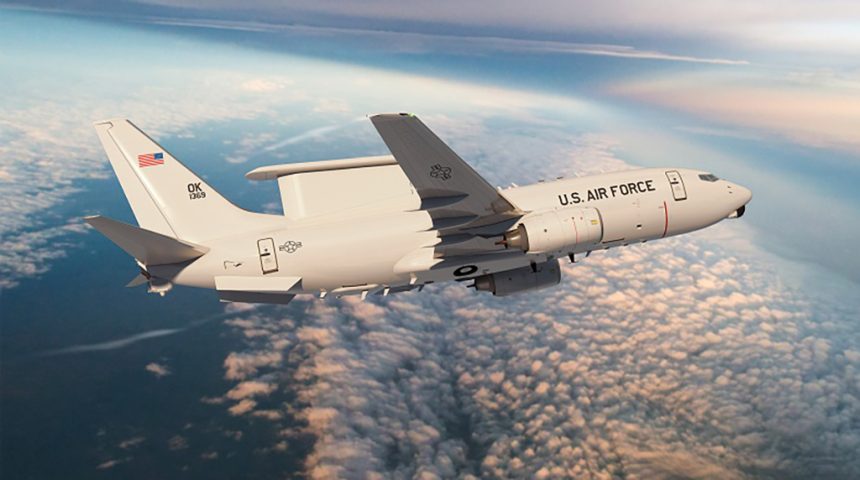The first E-7A is expected to be fielded by 2027, with a total expected order for 26 aircraft.
The Department of the Air Force is moving on with the E-7 to replace the aging E-3 Airborne Warning And Control System, awarding a not-to-exceed $1.2 billion contract to Boeing to start development activities for the E-7A Rapid Prototype program. The E-7 was selected in 2022 to replace the E-3, leading to the establishment of the E-7A Program Management Office and now the acquisition of the first two aircraft through the rapid prototyping acquisition pathway.
“The E-7A will be the department’s principal airborne sensor for detecting, identifying, tracking, and reporting all airborne activity to Joint Force commanders,” said Andrew Hunter, assistant secretary of the Air Force for Acquisition, Technology and Logistics. “This contract award is a critical step in ensuring that the department continues delivering battlespace awareness and management capabilities to U.S. warfighters, allies and partners for the next several decades. The E-7A will enable greater airborne battlespace awareness through its precise, real-time air picture and will be able to control and direct individual aircraft under a wide range of environmental and operational conditions.”
The E-7A will provide advanced Airborne Moving Target Indication and Battle Management, Command and Control capabilities, and advanced Multi-Role Electronically Scanned Array radar that enhances airborne battle management and enables long-range kill chains with potential peer adversaries. The E-7 was initially developed for the Royal Australian Air Force under “Project Wedgetail” and later adopted by the Republic of Korea Air Force, Turkish Air Force and the United Kingdom’s Royal Air Force.
“The E-7 is a proven platform,” said Stu Voboril, E-7 program vice president and general manager. “It is the only advanced aircraft that is capable of meeting the U.S. Air Force’s near-term Airborne Early Warning & Control requirement while enabling integration across the joint force.”
The E-7 is obtained by conversion from the commercial Boeing 737-700, capitalizing on the existing aircraft design, certification and modification processes which, together with a well-established supply chain, will reduce development, maintenance and logistics costs as well as the time needed before it can be fielded. Boeing said in a press release that two variants of the E-7 will developed, but did not provide further details. Some analysts suggested two examples of the same variant will be built and not two different ones for the USAF.

Boeing says the E-7 provides a fully integrated, combat-proven, flexible command and control node that delivers multi-domain awareness in the most challenging operational environments. The E-7’s open systems architecture and agile software design enable the aircraft’s capabilities to evolve and remain ahead of future threats.
Compared to legacy systems, the OMS architecture allows to add new or improved capabilities on operational aircraft very quickly and at a reduced cost, which is also very convenient in an era of continuous defense budget restraints. In 2020 Boeing announced that works were in progress to upgrade the E-7 by integrating Open Mission Systems-compliant components. Specifically, Boeing integrated its Battle Management Command and Control (BMC2) system with an unspecified advanced wide-band Active Electronically Scanned Array (AESA) radar developed by Northrop Grumman.
Northrop Grumman is the developer of the Multi-role Electronically Scanned Array (MESA) radar located on a dorsal fin on top of the E-7’s fuselage, which provides 360-degree surveillance capability (although it doesn’t rotate like the E-3 Sentry’s antenna) with both air-to-air and air-to-surface coverage with and integrated Identification Friend or Foe system. MESA provides the warfighter with critical domain awareness to detect and identify adversarial targets at long range and dynamically adjusts to emerging tactical situations, said the press release.
The development work is expected to be complete by August 2024, according to the contract notice. The USAF plans to begin production in fiscal 2025, with the first E-7A expected to be fielded by fiscal 2027. The service anticipates procuring 24 additional E-7As by fiscal 2032, with a total projected aircraft inventory of 26 aircraft. In the meanwhile, the E-3 is being upgraded to continue providing worldwide Battle Management, Command and Control and Airborne Moving Target Indication Operations until the E-7 is ready to be fielded.
“We conducted a thorough analysis of viable industry options to ensure the selected E-3 replacement could meet the specific needs of the U.S. Until the E-7A is fielded, we will continue to rely on the E-3 AWACS,” Hunter said. “The rapid prototyping program will integrate U.S.-based mission systems into the existing airborne platform to meet DAF requirements while simultaneously ensuring interoperability with coalition and allied partners already operating the E-7A.”









